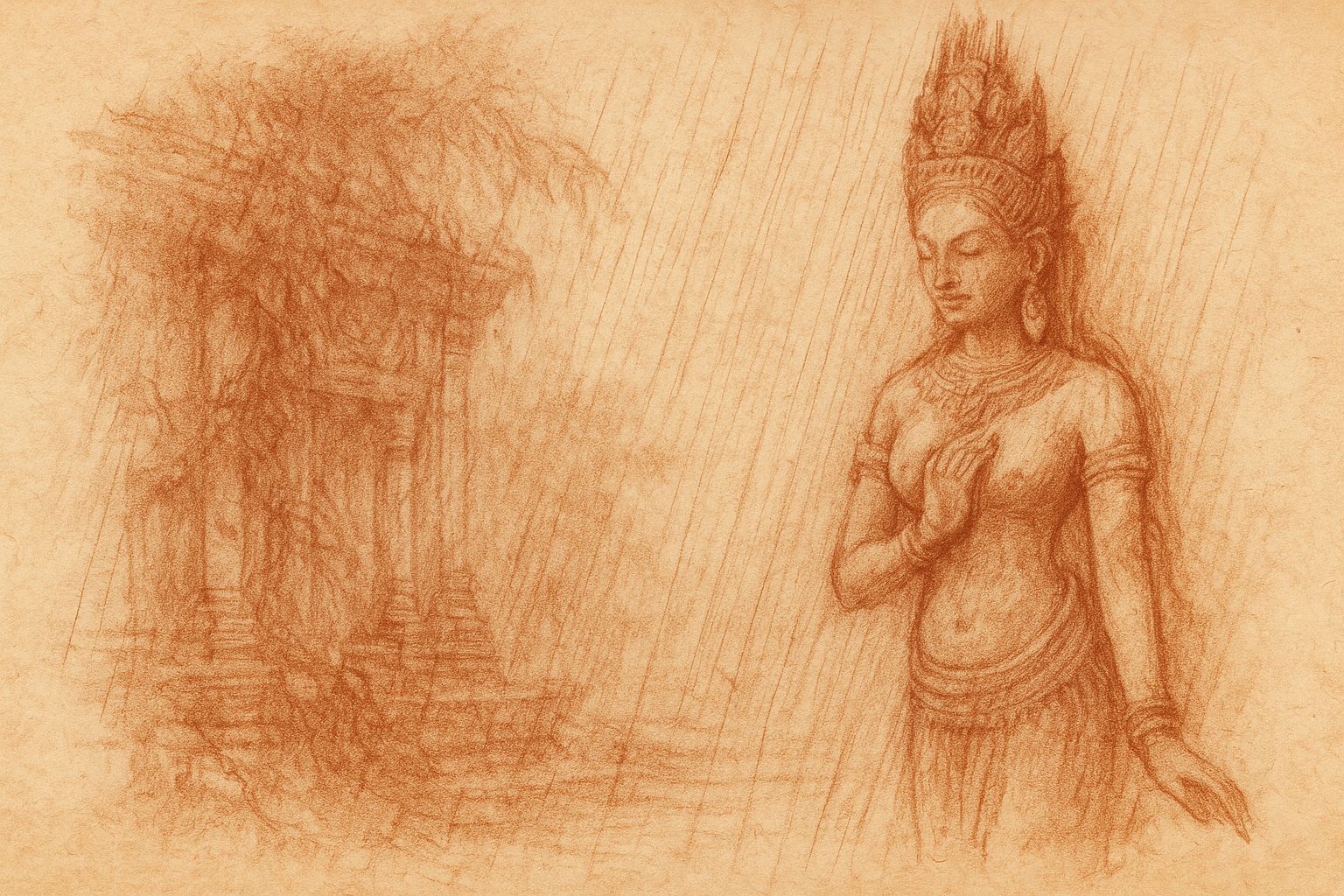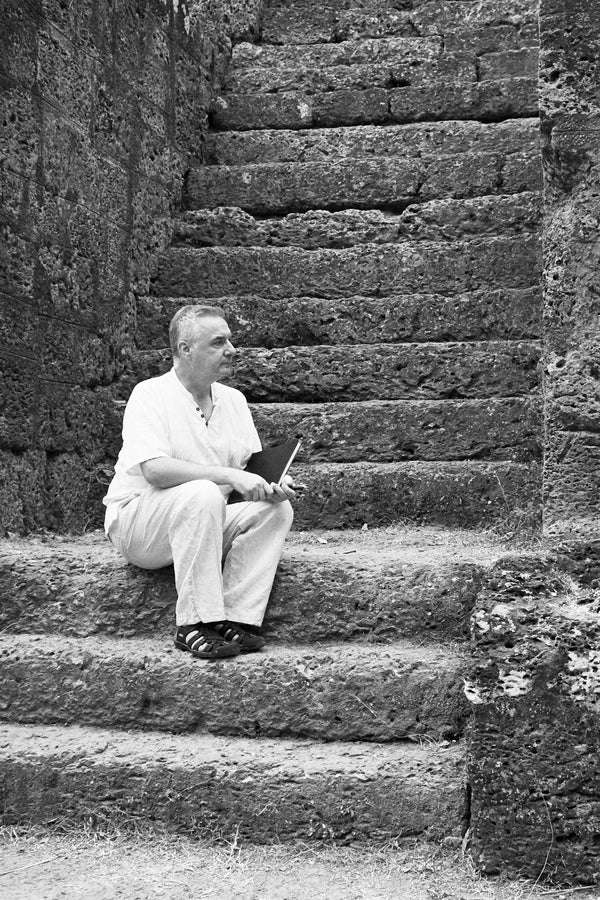Complimentary worldwide shipping on orders over $400 · No import tariffs for most countries
Complimentary worldwide shipping on orders over $400 · No import tariffs for most countries

The Apsara in Rain
4 min read
her face dissolves
in veils of falling water—
smile blurred into stonelichen holds the trace
of a vanished eyelid,
yet rain draws another mouth,
softer, unfinished, true
Rain had thinned the sandstone until the apsara’s features blurred, a face once cut in high relief now softened into shadow. I wrote with a damp sketchbook under the gallery vault, listening to how the silence pressed forward as if the temple itself inhaled. In such moments one begins to understand that these monuments are not only carved surfaces but living thresholds: stone that resists, remembers, and receives. Even the sudden lift of a bird from the lintel seemed less a distraction than a continuation of the ritual, carrying into the present a weight of centuries the body can feel but never fully name.
—
The apsaras — those celestial dancers who line the galleries of Angkor — are often introduced in guidebooks as decorative motifs. Their purpose, we are told, was to celebrate feminine beauty, to charm the visitor, to soften the austerity of monumental walls. Yet standing before one in the rain, one realises how inadequate such explanations are. Decoration is too weak a word. These faces are not adornments; they are presences. Each one seems to carry a distinct temperament — some serene, some amused, some gazing into distances we cannot measure.
The erosion of features does not erase their vitality. On the contrary, the softening makes the encounter more poignant. A cheek blurred into lichen, a nose half-crumbled, lips melted into shadow — these are not failures of preservation but revelations of impermanence. The apsara does not resist time; she absorbs it. Rain becomes her veil, moss her jewellery, fracture her expression. To look upon her is to witness an unending dance between what endures and what fades.
—
As I sketched that morning, I thought of how often Angkor is described as a “lost city” reclaimed by the jungle. But perhaps it is more accurate to say it was never lost, only changed in tempo. Stone accepts rain differently from the way skin does, yet both are subject to the same law of wearing down. The apsara in front of me bore the traces of centuries the way a face bears years: with dignity, with inevitability.
This perspective unsettles our modern habits of preservation. We tend to see decay as an enemy, something to halt, clean away, restore. But the apsara seemed to suggest another possibility: that beauty is not diminished by weathering, only altered in character. She teaches a slower rhythm of appreciation, one where imperfection is part of the truth. The Japanese word wabi-sabi comes to mind, though the concept here is distinctly Khmer — a reverence for the way stone and rain converse, an acceptance that eternity is written in slow dissolutions.
—
From the gallery I could see how the carvings stretched in long processions, hundreds of apsaras repeating across the temple’s face. Some were still sharp, their jewellery intact, their smiles precise. Others had nearly vanished into the wall. It struck me that this variation itself was part of the design, as if the temple were teaching us to recognise beauty not only in perfection but in its gradual fading. A visitor is invited to walk the full spectrum: from clarity to blur, from presence to memory.
The apsara I sketched seemed poised between those extremes. Her headdress still rose in intricate tiers, catching beads of water. Her mouth, though softened, still curved with a suggestion of laughter. Yet her eyes were nearly gone, hollowed by rain. And it was precisely this incompleteness that held me. To meet a gaze that is no longer there is to be reminded of one’s own mortality: we too will be reduced to traces, outlines, half-remembered gestures. The stone speaks of this without cruelty, only with the patience of centuries.
—
Later, when the rain eased, I walked outside and looked back at the gallery wall. The apsaras seemed to emerge differently in the shifting light — some almost disappearing when shadow fell, others glowing faintly when sun returned. It was as though the temple were staging its own theatre, dancers stepping forward and retreating depending on the mood of the sky. And I realised: the apsaras are not fixed statues. They are performances in stone, choreographed by weather and light. Their dance continues as long as time does.
This understanding changes how one approaches Angkor. It is not simply an archaeological site to be catalogued, nor a tourist spectacle to be photographed. It is a living stage, where memory and material are constantly in motion. The apsara in rain is no less real than the apsara newly cleaned or restored. Each carries a different tone of truth.
—
At the close of my sketch I traced not the lines of her face but the drip of water falling from her cheek. That line seemed more honest than any attempt to reconstruct her original form. The drip marked the present moment — my presence there, the day’s weather, the meeting of centuries in a single drop. When I left, the page in my book was mottled and warped. The drawing blurred where raindrops struck, just as the stone blurred in the rain. It seemed fitting. The sketch was not a record of permanence but a witness to change.
—
When I return to that gallery, I know she will look different. Perhaps more lichen will spread, perhaps a piece of stone will have fallen. Yet I do not fear the change. The apsara’s lesson is precisely that transformation is the only true continuity. She dances by dissolving, and her grace lies in the way she accepts what comes.
Standing in the gallery that morning, with rain thinning her features, I felt not sadness but reverence. The apsara was still there, and not there, all at once. Her silence was not emptiness but invitation — to watch, to remember, to join the slow choreography of impermanence.
Celestial Grace: Apsaras of Angkor
Photographs from the Spirit of Angkor series by Lucas Varro
“They were never carved by the hands of men!
They were created by the Gods—living, lovely, breathing women!”
—Pang, 17th-century Cambodian poet
Without the apsaras, the temples of Angkor would speak in stone alone. It is these celestial dancers—carved in endless variations of grace, mystery, and joy—who draw breath into the stone, transforming solemn sanctuaries into radiant realms of divine presence. Their gestures are not stillness, but suspended movement. Their smiles are not fixed, but eternal.
In Khmer cosmology, the apsaras were sky-dwellers—attendants of the gods, embodiments of beauty, dream, and sacred rhythm. Their presence on temple walls was no ornamentation, but invocation. They were carved to welcome the gods, and by extension, to guide all who entered—bathing the pilgrim’s path in a sense of heavenly arrival.
In this collection of fine art photographs from the Spirit of Angkor series, Lucas Varro turns his lens toward these divine figures with the eye of reverence and the patience of prayer. Captured on medium and large format black-and-white film, shaped by chiaroscuro and hand-toned with care, each image reveals the quiet spirit within the stone—the breath behind the smile.
These limited edition prints, offered on hand-toned archival Hahnemühle Bamboo paper, are accompanied by a Collector’s Print Package including poetic writings, curatorial texts, and artist’s field reflections. Each one invites you not only to witness—but to be welcomed.
To enter this gallery is to step, as the ancients did, into a palace of the gods. And the apsaras are waiting.
Join My Studio Journal
Receive occasional letters from my studio in Siem Reap—offering a glimpse into my creative process, early access to new fine art prints, field notes from the temples of Angkor, exhibition announcements, and reflections on beauty, impermanence, and the spirit of place.
No noise. No clutter. Just quiet inspiration, delivered gently.
Subscribe and stay connected to the unfolding story.

Join My Studio Journal
Receive occasional letters from my studio in Siem Reap—offering a glimpse into my creative process, early access to new fine art prints, field notes from the temples of Angkor, exhibition announcements, and reflections on beauty, impermanence, and the spirit of place.
No noise. No clutter. Just quiet inspiration, delivered gently.
Subscribe and stay connected to the unfolding story.











































